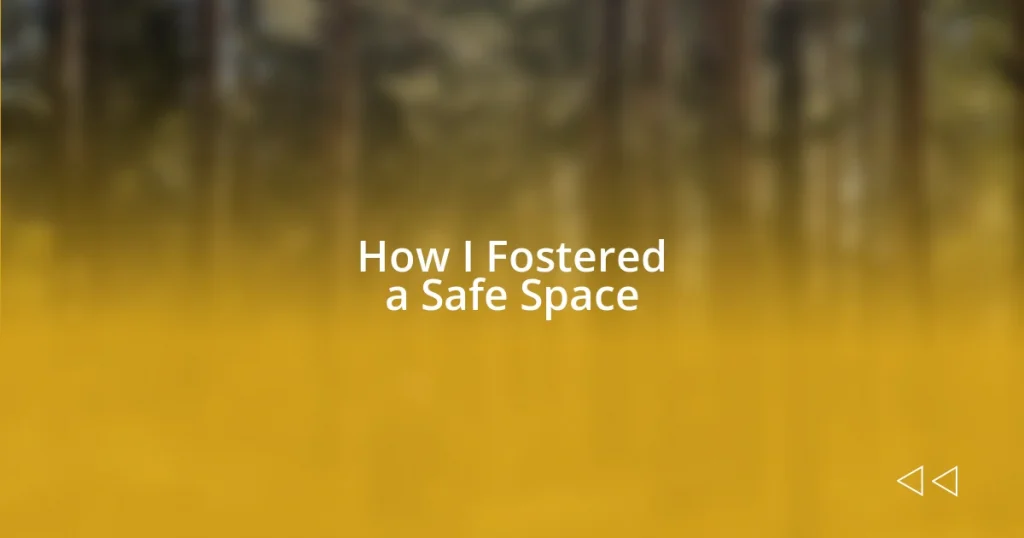Key takeaways:
- A safe space fosters emotional security and acceptance, emphasizing the value of vulnerability and trust in communication.
- Creating a physically safe environment involves comfort, accessibility, and clear signage, ensuring everyone feels included and welcome.
- Regular evaluation and feedback mechanisms, like anonymous surveys and collective check-ins, are essential for ongoing improvement and collective responsibility within the space.

Understanding Safe Spaces
A safe space is more than just a physical location; it’s a feeling of emotional security and acceptance. I remember the first time I stepped into a community gathering where everyone openly shared their experiences. It felt magical, as if the walls held stories that resonated with my own, leaving me wondering, how often do we truly feel seen and heard in our daily lives?
Understanding safe spaces involves recognizing the importance of vulnerability and trust. I’ve had moments where I hesitated to express myself, fearing judgment or misunderstanding. Yet, when I found that one group where my thoughts were met with empathy instead of criticism, I realized how crucial it is for people to have environments that encourage honesty without fear.
When we talk about safe spaces, we often think about inclusivity, but what does that really mean? It’s not just about physical safety; it’s about creating a culture where everyone feels valued, regardless of their background. In my experience, these spaces challenge us to confront uncomfortable truths while offering the support we need to grow. It makes me ask—how can we cultivate a sense of belonging in our own circles?

Identifying Needs for Safety
Identifying the needs for safety begins with active listening. I recall a workshop I attended where facilitators encouraged participants to express their emotional needs. For me, it was a gentle reminder that safety isn’t about imposing rules but rather about nurturing an environment where everyone feels valued and heard. Recognizing these needs is essential; it can be the key to unlocking authentic communication and trust within a group.
To effectively assess safety needs, consider these factors:
- Emotional Validation: Are participants feeling heard and acknowledged?
- Physical Space: Is the environment comfortable and accessible for everyone?
- Personal Boundaries: Are individual limits respected by the group?
- Diversity and Inclusion: Do all voices have an equal chance to be shared and honored?
- Conflict Resolution: Is there a clear process for addressing disagreements respectfully?
Reflecting on these aspects can paint a clearer picture of what safety means for everyone involved, fostering a deeper sense of community.

Creating Physical Safety Elements
Creating a physically safe environment starts with basics, like ensuring a clean and welcoming space. I once attended a retreat where the organizers painted the walls in inviting colors and provided comfortable seating. Immediately, I felt at ease. The right colors and layouts can not only set the mood but also signal to participants that they are in a place designed for comfort and openness.
When it comes to safety, accessibility is paramount. I remember a community event I hosted where we made sure that there were ramps and designated seating for those with mobility challenges. It transformed the experience for everyone involved. Everyone deserves to feel included and secure in their surroundings.
Lastly, I can’t overstate the importance of clear signage and well-organized layouts. At another gathering, I noticed how directional signs helped newcomers navigate the space confidently. It minimized the anxiety of not knowing where to go or whom to approach. I think those physical elements not only give a sense of order but also create an atmosphere of inclusivity and support.
| Element | Importance |
|---|---|
| Color and Decor | Sets a welcoming tone and enhances comfort |
| Accessibility Features | Ensures inclusion for all participants |
| Signage | Guides newcomers and reduces anxiety |

Establishing Emotional Safety Practices
Establishing emotional safety practices is essential to nurturing trust within any community. One approach I’ve found effective is creating an open dialogue about feelings. During a team meeting, I introduced a “check-in” round where everyone shared their current emotional state. It felt like unlocking a door; suddenly, people were more honest, more willing to express concerns, and connections deepened immensely. Doesn’t it feel good to know that your emotions are not just acknowledged but welcomed?
Another crucial practice is creating a culture of respect for vulnerabilities. I once shared a personal experience about a professional setback, and to my surprise, several colleagues followed suit. That moment was powerful; it showed me that authenticity breeds safety. By embracing our imperfections, we laid a foundation that allowed everyone to feel safer discussing sensitive issues. Are we not all craving spaces where we can truly be ourselves without judgment?
I also recommend setting clear guidelines that promote positivity and support during discussions. When I facilitated a workshop, we agreed on a simple rule: “Listen without interrupting.” This small adjustment transformed our interactions. I could see how participants felt encouraged to share thoughts without fear of dismissal. It reminded me that sometimes, practicing emotional safety is as simple as creating the right conditions for a meaningful exchange.

Encouraging Open Communication
Encouraging open communication is fundamental to creating those safe spaces we all crave. One approach I love to use is open-ended questions during group discussions. I recall a time in a workshop where I asked, “What do you think we can improve?” The flood of responses that followed revealed a world of insight I hadn’t anticipated. It was amazing to see how much people wanted to share when they felt their opinions were genuinely invited.
Another technique I’ve found to be particularly effective is establishing “communication norms.” For instance, I once led a discussion group where we agreed to always give each other our full attention. When someone spoke, everyone else would actively listen, nodding or making brief comments to show engagement. This practice not only built respect but also made individuals feel valued and understood. Doesn’t it just make sense that when someone feels heard, they’re more likely to contribute openly?
Lastly, sharing my own thoughts and vulnerabilities creates a ripple effect. During a session, I opened up about my struggles with a recent project, and soon others followed suit, sharing their own challenges. It was enlightening to realize that transparency fosters a deeper connection. The more honest we are about our experiences, the more we encourage others to do the same. Isn’t it wonderful to think about how such small shifts in our communication can lead to profound changes in the way we relate to one another?

Building Trust within the Space
Building trust within a space requires a conscious effort to be reliable and consistent. I remember a time when I committed to sending out feedback summaries after every meeting. Initially, it felt like a small gesture, but it quickly became a cornerstone of our operations. Participants began relying on these summaries as a safe touchpoint to revisit decisions and discussions. It made me wonder, how often do we underestimate the power of small commitments in building trust?
Additionally, being open about my own uncertainties has profoundly impacted the trust dynamic in my groups. In one instance, I admitted to feeling overwhelmed by a challenging project timeline, which led to numerous colleagues sharing their own pressures and struggles. We realized together that it’s okay not to have it all figured out. This type of vulnerability is often the bridge that connects us, isn’t it?
I’ve also found that celebrating successes, no matter how small, helps cement trust in the space. After a particularly intense project, we took a moment to highlight individual contributions. The gratitude expressed was palpable and created an uplifting atmosphere where everyone felt recognized. Reflecting on that moment, it struck me how acknowledging each other not only fosters trust but also strengthens our sense of belonging. Don’t you think those moments of recognition can transform simply functioning teams into cohesive units?

Evaluating and Improving the Space
Evaluating the effectiveness of your safe space is essential for its continued growth and improvement. After facilitating a series of discussions, I found it incredibly eye-opening to observe the dynamic shifts in participation. I remember one meeting where we took a moment to reflect collectively on what was working and what wasn’t. The honest exchange that followed helped me realize areas where we could make adjustments – like tweaking our meeting times to ensure everyone could participate. Isn’t it fascinating how a simple reflection can unveil such clarity?
To keep the momentum going, I often utilize anonymous surveys as a tool for evaluation. This method has allowed individuals to voice their thoughts without the fear of being judged. I still recall one response that highlighted a lack of clarity in our shared goals. Although it stung at first, it spurred me into action. We ended up collaborating on a clearer vision statement, which not only aligned our efforts but also made everyone feel truly invested. How often do we allow feedback to transform our spaces for the better?
Moreover, regular check-ins have become a staple in my approach, serving as a touchstone for ongoing improvements. In one instance, I introduced brief quarterly reviews, which would include both accomplishments and areas for growth. The atmosphere during these sessions was electric; people felt empowered to contribute to an evolving narrative. It was during these moments that I realized the power of collective responsibility. Isn’t it inspiring to think that we can all take part in shaping our shared experiences?















